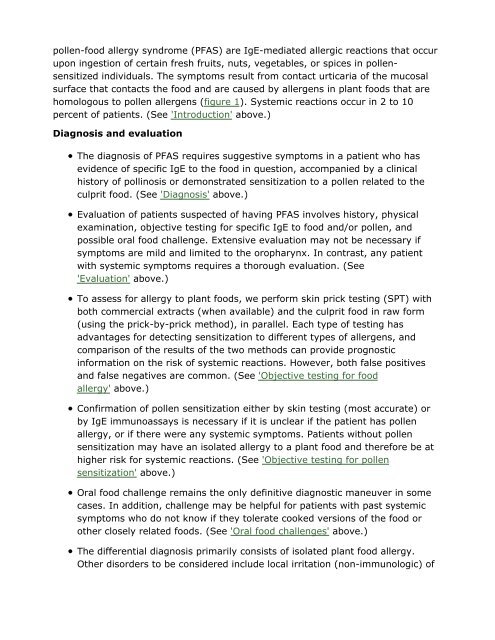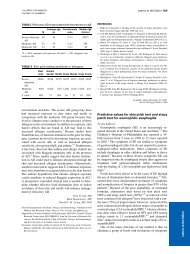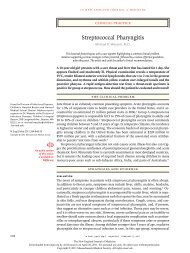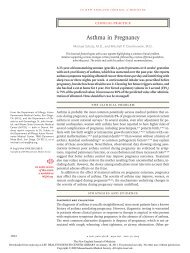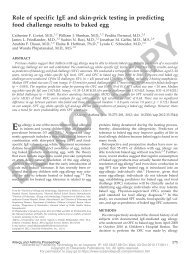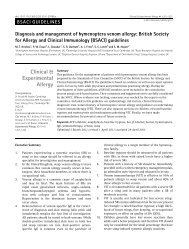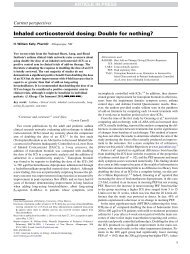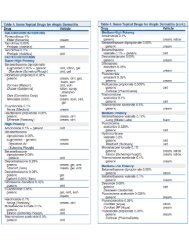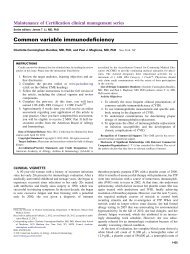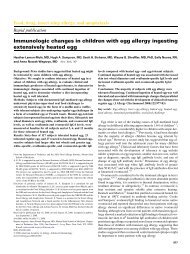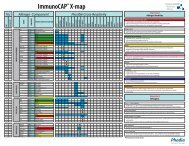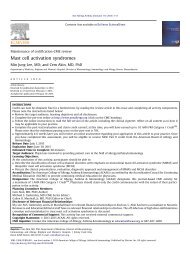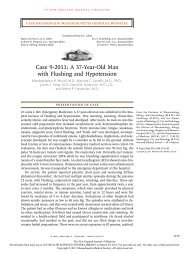Diagnosis and management of oral allergy syndrome ... - AInotes
Diagnosis and management of oral allergy syndrome ... - AInotes
Diagnosis and management of oral allergy syndrome ... - AInotes
You also want an ePaper? Increase the reach of your titles
YUMPU automatically turns print PDFs into web optimized ePapers that Google loves.
pollen-food <strong>allergy</strong> <strong>syndrome</strong> (PFAS) are IgE-mediated allergic reactions that occur<br />
upon ingestion <strong>of</strong> certain fresh fruits, nuts, vegetables, or spices in pollensensitized<br />
individuals. The symptoms result from contact urticaria <strong>of</strong> the mucosal<br />
surface that contacts the food <strong>and</strong> are caused by allergens in plant foods that are<br />
homologous to pollen allergens (figure 1). Systemic reactions occur in 2 to 10<br />
percent <strong>of</strong> patients. (See 'Introduction' above.)<br />
<strong>Diagnosis</strong> <strong>and</strong> evaluation<br />
The diagnosis <strong>of</strong> PFAS requires suggestive symptoms in a patient who has<br />
evidence <strong>of</strong> specific IgE to the food in question, accompanied by a clinical<br />
history <strong>of</strong> pollinosis or demonstrated sensitization to a pollen related to the<br />
culprit food. (See '<strong>Diagnosis</strong>' above.)<br />
Evaluation <strong>of</strong> patients suspected <strong>of</strong> having PFAS involves history, physical<br />
examination, objective testing for specific IgE to food <strong>and</strong>/or pollen, <strong>and</strong><br />
possible <strong>oral</strong> food challenge. Extensive evaluation may not be necessary if<br />
symptoms are mild <strong>and</strong> limited to the oropharynx. In contrast, any patient<br />
with systemic symptoms requires a thorough evaluation. (See<br />
'Evaluation' above.)<br />
To assess for <strong>allergy</strong> to plant foods, we perform skin prick testing (SPT) with<br />
both commercial extracts (when available) <strong>and</strong> the culprit food in raw form<br />
(using the prick-by-prick method), in parallel. Each type <strong>of</strong> testing has<br />
advantages for detecting sensitization to different types <strong>of</strong> allergens, <strong>and</strong><br />
comparison <strong>of</strong> the results <strong>of</strong> the two methods can provide prognostic<br />
information on the risk <strong>of</strong> systemic reactions. However, both false positives<br />
<strong>and</strong> false negatives are common. (See 'Objective testing for food<br />
<strong>allergy</strong>' above.)<br />
Confirmation <strong>of</strong> pollen sensitization either by skin testing (most accurate) or<br />
by IgE immunoassays is necessary if it is unclear if the patient has pollen<br />
<strong>allergy</strong>, or if there were any systemic symptoms. Patients without pollen<br />
sensitization may have an isolated <strong>allergy</strong> to a plant food <strong>and</strong> therefore be at<br />
higher risk for systemic reactions. (See 'Objective testing for pollen<br />
sensitization' above.)<br />
Oral food challenge remains the only definitive diagnostic maneuver in some<br />
cases. In addition, challenge may be helpful for patients with past systemic<br />
symptoms who do not know if they tolerate cooked versions <strong>of</strong> the food or<br />
other closely related foods. (See 'Oral food challenges' above.)<br />
The differential diagnosis primarily consists <strong>of</strong> isolated plant food <strong>allergy</strong>.<br />
Other disorders to be considered include local irritation (non-immunologic) <strong>of</strong>


